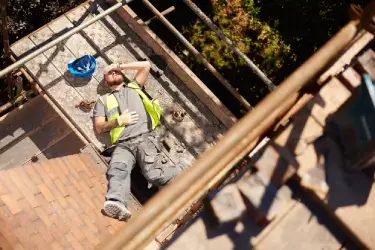Construction sites are naturally dangerous, and working on a roof poses a particularly high risk for laborers. In New York, construction roof accidents are a leading cause of serious injuries and fatalities. Understanding how these accidents occur and knowing how to pursue legal action is crucial for ensuring justice and preventing further harm.
Common Causes of Roof Accidents
- Falls from Heights: Falls are the most common cause of roof related accidents. Workers often lose your footing due to slippery surfaces, loose materials, or unstable scaffolding. Lack of adequate fall protection systems, such as harnesses and guardrails, significantly increases the risk.
- Improper Training: Workers who lack proper training may not be fully aware of the risks associated with roof work. They may also mishandle tools or fail to safely use the equipment correctly, leading to accidents.
- Defective Equipment: Ladders, scaffolds, and other equipment used for roof work must be in proper working condition. Defective or poorly maintained equipment can collapse or fail, causing injuries. Some roofs are also not structurally strong enough to support workers. Sudden collapses can occur, particularly in older buildings are growing bad weather.
- Falling Debris: Loose tools, materials, or debris can fall from roofs, injuring workers on lower levels or causing hazards to those nearby.
- Legal Protections: New York has some of the strongest laws in the country when it comes to construction accidents. These labor laws ensure that workers injured in roof accidents have pathways to seek compensation and hold responsible parties accountable.
New York Labor Law 240 (Scaffold Law)
This law provides strict liability for property owners and general contractors if a worker is injured due to inadequate fall protection. It covers accidents involving scaffolds, ladders, and other elevation related equipment.
New York Labor Law Section 241
Section 241 requires construction sites to adhere to strict safety standards. If a worker is injured due to a violation of these regulations, they may have grounds for legal action.
Workers’ Compensation
Workers injured on the job are generally entitled to workers’ compensation benefits, which cover medical expenses and a portion of lost wages. However, these benefits may not fully compensate for pain, suffering, or other damages.
3rd Party Lawsuits
In addition to workers compensation, injured workers may file third party construction lawsuits against parties other than their employer. For example, they can sue equipment manufacturers for defective products or subcontractors for negligence.
Steps to Take After a Roof Accident

Your health and safety should be your top priority quick medical treatment also creates a record of your injuries, which is essential for legal claims later on. Notify your employer or supervisor as soon as possible. New York law requires workers to report workplace injuries within 30 days to qualify for workers compensation benefits.
Collect evidence such as photos of the accident scene, your injuries, and any defective equipment. If possible, gather witness statements from coworkers who saw the accident. Roof accidents often involve multiple parties and complex legal issues. A qualified construction accident attorney can help you understand your rights, navigate the legal system, and maximize your compensation.
How Legal Action Can Help
- Financial Recovery: Compensation can cover medical bills, lost wages, and damages like pain and suffering.
- Accountability: Holding negligent parties responsible can prompt stricter safety measures, preventing similar accidents.
- Peace of Mind: Legal representation ensures that your rights are protected while you focus on recovery.
Construction roof accidents in New York and have devastating consequences for workers and their families. Understanding the causes and the legal options available is critical for ensuring justice. By working with experienced attorneys and utilizing New York’s robust labor laws, injured workers can secure the compensation and deserve and contribute to safer workplaces. Call us if you or someone you know has been the victim of a roof accident.


